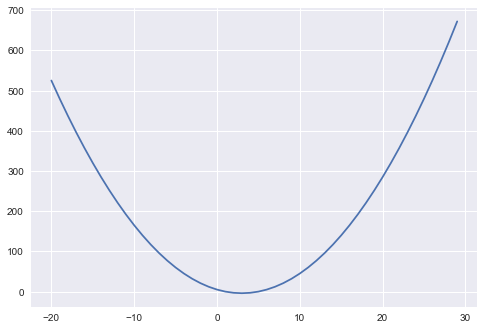Keywords: calculus | optimization | gradient descent | Download Notebook
Contents
Contents
%matplotlib inline
import numpy as np
import seaborn as sns
import matplotlib.pyplot as plt
import matplotlib.animation as animation
You will need to install the following package to get things to work.
pip install git+https://github.com/jakevdp/JSAnimation.git
A lot of the animations here were adapted from: http://tillbergmann.com/blog/python-gradient-descent.html
from JSAnimation import IPython_display
xlist=np.arange(-20,30,1)
f = lambda x: x**2-6*x+5
flist = [f(x) for x in xlist]
plt.plot(xlist, flist);

The Basic Idea of gradient Descent
The gradient is the direction of steepest change. This direction does not matter in 1d, but the idea in 1d is the same: you move by the amount of your derivative times a step size. Too small a step, and you take for ever to go down the hill. To much a step and you overshoot, oscillate around, and then finally make it.
Step size is important.
#adapted from http://tillbergmann.com/blog/python-gradient-descent.html
def grad_des1d(f, fprime, step=0.01, maxsteps=0, precision=0.001, start=25):
mins = []
costs = []
old=0
current = start
mins.append(start)
counter = 0
while abs(current - old) > precision:
old = current
gradient = fprime(old)
move = gradient * step
current = old - move
mins.append(current)
if maxsteps:
counter+=1
if counter == maxsteps:
break
return mins
def animator(f, xvals, xdatafn, ydatafn, frameskip, ax, line):
fvals=[f(x) for x in xvals]
ax.plot(xvals, fvals, lw=3)
line, = ax.plot([], [], "D", markersize=12)
def init():
line.set_data([], [])
return line,
def animate(i):
x_n = xdatafn(i, frameskip)
y_n = ydatafn(i)
line.set_data(x_n, y_n)
return line,
return init, animate
fmins = grad_des1d(f, lambda x: 2*x - 6)
fig = plt.figure(figsize=(10, 6))
ax = plt.axes()
ax.plot(xlist,flist, linewidth=4 )
line, = ax.plot([], [], "D", markersize=12)
fskip=10
xdatafn = lambda i, fskip: fmins[0::fskip][i]
ydatafn = lambda i: f(xdatafn(i, fskip))
i, a = animator(f, xlist, xdatafn, ydatafn, fskip, ax, line)
anim = animation.FuncAnimation(fig, a, init_func=i,
frames=len(fmins[0::fskip]), interval=200)
anim.save('images/1dgd.mp4')
anim
</input>
fmins2 = grad_des1d(f, lambda x: 2*x - 6, step=0.8, maxsteps=100)
fig = plt.figure(figsize=(10, 6))
ax = plt.axes()
ax.plot(xlist,flist, linewidth=4 )
line, = ax.plot([], [], "D", markersize=12)
fskip2=1
xdatafn = lambda i, fskip: fmins2[0::fskip2][i]
ydatafn = lambda i: f(xdatafn(i, fskip2))
i, a = animator(f, xlist, xdatafn, ydatafn, fskip2, ax, line)
anim = animation.FuncAnimation(fig, a, init_func=i,
frames=len(fmins2[0::fskip2]), interval=400)
anim.save('images/1dgd-bigstep.mp4')
anim
</input>
fmins3 = grad_des1d(f, lambda x: 2*x - 6, step=0.001, maxsteps=100)
fig = plt.figure(figsize=(10, 6))
ax = plt.axes()
ax.plot(xlist,flist, linewidth=4 )
line, = ax.plot([], [], "D", markersize=12)
fskip3=10
xdatafn = lambda i, fskip: fmins3[0::fskip3][i]
ydatafn = lambda i: f(xdatafn(i, fskip3))
i, a = animator(f, xlist, xdatafn, ydatafn, fskip3, ax, line)
anim=animation.FuncAnimation(fig, a, init_func=i,
frames=len(fmins3[0::fskip3]), interval=200)
anim.save('images/1dgd-smallstep.mp4')
anim
</input>